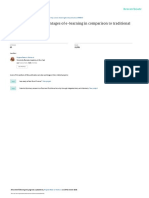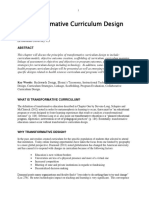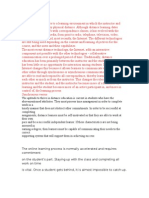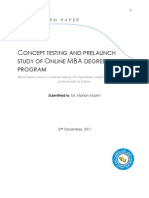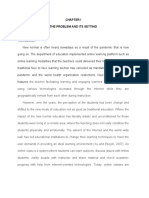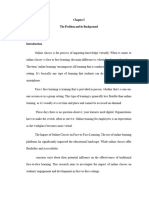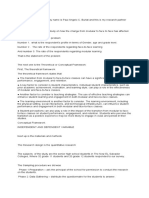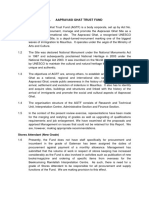Professional Documents
Culture Documents
Conlon 1997
Conlon 1997
Uploaded by
AngelooOriginal Title
Copyright
Available Formats
Share this document
Did you find this document useful?
Is this content inappropriate?
Report this DocumentCopyright:
Available Formats
Conlon 1997
Conlon 1997
Uploaded by
AngelooCopyright:
Available Formats
See discussions, stats, and author profiles for this publication at: https://www.researchgate.
net/publication/2379927
Back to Basics: Using Adult Learning Principles to Create E-Learning Success
Article · October 2001
Source: CiteSeer
CITATIONS READS
0 494
1 author:
Steven Aragon
Texas State University
33 PUBLICATIONS 2,561 CITATIONS
SEE PROFILE
All content following this page was uploaded by Steven Aragon on 06 February 2013.
The user has requested enhancement of the downloaded file.
Back to Basics: Using Adult Learning Principles
to Create E-Learning Success
Steven R. Aragon
Human Resource Education
University of Illinois at Urbana-Champaign, USA
aragon@uiuc.edu
Abstract: While online instructional is gaining popularity, many educators and trainers
are not advocates of online instruction because of the belief it can actually solve difficult
teaching and learning problems. However, with the recent and continued advancements
in technology, designers of education and training programs no longer need to be at the
mercy of what is available or its cost. The learner can now be put back at the center of
learning and now be the unit around which education and training programs are designed.
Therefore, the question to be asked is what does and online program look like that puts
the learner back at the center of learning? This paper will review some basic principles
of adult learning and show how they were incorporated into the design of a successful
Masters of Education (M.Ed.) online program in a large mid-western university.
Introduction
Whether learning takes place in an institution of higher education or in a private, public, or non-
profit organization, participants are expected to learn and subsequently apply their new knowledge.
During recent years, innovations in higher education have served as a catalyst for changing relationships
among students and teachers (Dziuban & Dziuban, 1997). New advances in Internet-based technology
have brought challenges and opportunities to education and training, in particular through online
instruction. Online instruction is a form of distance education delivered over the Internet. For many, this
type of instruction is perceived as a major breakthrough in teaching and learning because it facilitates the
exchange of information and expertise while providing opportunities for learners in distant of
disadvantaged locations (Webster & Hackey, 1997).
While online instruction is gaining popula rity, it is not free from criticism. Many educators and
trainers are not advocates of online instruction because they do not believe it actually solves difficult
teaching and learning problems (Conlon, 1997) while others are concerned about the many barriers that
hinder effective online teaching and learning. These concerns include the changing nature of technology,
the complexity of networked systems, the lack of stability in online learning environments, and the
limited understanding of how much students and instructors need to know to successfully participate
(Brandt, 1996). For others, online instruction also threatens to commercialize education, isolate students
and faculty, and may reduce standards or even devalue university degrees (Gallick, 1998).
Advocates of Internet-based education are largely positive and optimistic (Relan & Gillani, 1997)
about its potential. But before it can be fully accepted by the mainstream public and educational
community, many challenges must be addressed (Hill, 1997). Primary among these challenges is how to
meet the expectations and needs of both the instructor and the student and how to design online courses so
they provide a satisfying and effective learning environment. From program developer and instructor
perspectives, understanding these issues is critical for the development and implementation of quality
online instruction.
Back to Basics 1 Aragon
SSSGRR 2001
Purpose
The purpose of this paper is to illustrate how one large mid-western university was able to
successfully create and implement an online Masters of Education (M.Ed.) degree program around
theoretically based principles of adult learning. By placing learners back at the center of learning, this
online program has seen success in terms of retention; equal academic performance when compared to the
on-campus program; and no significant correlations between learning style preferences and delivery
format.
Beyond K-12 Education
Human Resource Education: A Description
While the focus of most education programs is on K-12 teacher education, human resource
education (HRE) is focused on the training, education, and development of individuals who desire to
focus their education and skills in public and private organizations; military; government; and community
colleges. Graduates of HRE programs will focus on training and development; program evaluation;
and/or organizational development and change to name a few. Most programs of HRE have evolved out
of adult vocational education recognizing that learning is lifelong, not simply just skill-based, and does
not end at the completion of high school. In addition, HRE recognizes the continuous changing needs of
today’s workforce and organizations and prepares the individuals that will be able to meet these
challenges.
The HRE Department described as the unit of analysis in this paper has followed the evolution
process as described above. Students enrolled in this graduate program focus in one of two areas: human
resource development or community college leadership. The curriculum includes courses in the areas of
instructional design; instructional technologies and methods; program evaluation; organizational
development and strategic planning; and the history of field. The coursework is tailored and applied
within the context of the student’s focus area.
Program Description
The M.Ed. degree consists of 8 units (32 credit hours) of coursework. Both the campus and
online versions of the degree require 2 units of educational foundations. For the campus program,
students are able to select the remaining 6 units based on their interests and future goals. These courses
are selected in conjunction with advisor approval. For those students enrolled in the online program, the
coursework is pre-selected and all students move through the curriculum in a cohort model completing
courses on the same schedule. The additional 6 units consist of instructional technologies, instructional
design, HRE foundations, program evaluation, strategic planning, and organizational development. All
courses in the program were originally campus versions and later placed online with the same
requirements and standards. Although the online students do not have flexibility in being able to choose
their own courses, the program of studies between the two student groups (campus and online) look very
similar upon completion of the M.Ed. degree.
It is important to note that the policies and standards are the same for both the campus and online
programs in terms of GPA, fit of goals with the Department, and letters of support. It is also important to
mention that the requirements and standards for both the campus and online versions of each course are
the same as well. It has been important for the Department to ensure that HRE Online is not viewed as a
“watered-down” or simplistic version of the campus program.
Back to Basics 2 Aragon
SSSGRR 2001
Students
Students who enroll in the HRE Department are those seeking a career in training and
development, program evaluation, and/or organizational development and change. While students in the
campus program may already be working in the field and seeking the M.Ed. for advancement, all of the
online students are currently working in the field. They too seek the M.Ed. for advancement but due to
work constraints or geographical location are unable to enroll in a traditional campus program.
Consequently, the online option allows them the freedom and flexibility to complete a graduate degree
without attending courses on campus but still having the same academic rigor in a program. As Johnson,
Aragon, Shaik, and Palma-Rivas (2000) have found in the evaluation of the campus and online programs,
the demographics of the two types of students are not significantly different.
Principles of Adult Learning Theory
In their comprehensive review of adult learning theory, learning theorists (i.e., Merriam &
Caffarella, 1999) have identified principles that have been consistently found to describe what contributes
to learning successful for adults engaged in education, training, and development programs and activities.
While there still may be some debate over the terminology or the importance on the role of a particular
principle in the learning process, overall common agreement still exists on the nature of each principle.
These are briefly described in this section to provide the theoretical framework around which HRE Online
was developed. The application of these principles to the online program will be discussed in the
following section.
Learning is a Process. This principle reminds us that learning is an active and continuous
process. There is a proper sequence in which to present information so that maximum learning takes
place. Learning occurs or takes place by changes in behavior and demonstrated through the growth of
knowledge. Individuals will learn even when the instructor is doing a poor job. This principle also
reminds us that instructors should repeatedly check that participants are learning through the use of
various performance measurements.
Styles and Rate of Learning Vary. Learning styles and rate vary from one individual to the next.
For example, some individuals learn better by reading than they do by listening; some learn faster than
others (even among those who learn best using the same style). It is not uncommon to have learners of
five or six types in a single setting. It is the instructor’s job to determine the individuals’ different
learning styles and develop teaching strategies and activities that will best help them realize their
potential.
Readiness. Individuals learn dependent upon their readiness to do so, their emotional state, their
abilities, and their potential. This principle is commonly referred to as motivation. It includes, probably
most importantly, the desire to learn. The instructor’s job is to spark a desire to learn or to enhance an
existing desire. This is done by emphasizing the meaningfulness of the subject, exhibiting a sincere
enthusiasm for the subject, and by providing the incentive to learn.
Life Experiences. This principle reminds us that learning is influenced by the life experiences of
the learner. Imagine trying to teach someone how to tie different knots by referring to tying one’s
shoelace. It the learner had never tied a shoelace the reference would be useless. Most instructors will
not encounter such extremes, but the point is that we should have some knowledge of the individuals’
backgrounds and past experiences. Helping learners to recognize the similarities and differences between
past experiences and present situations will smooth the transfer of learning from one situation to the next.
Back to Basics 3 Aragon
SSSGRR 2001
In addition, relating what is being learned to what is already known will make the knowledge more
personal or relevant to the individual.
Application. This principle tells us that learning is more effective when there is immediate
application of what is being taught. Learners should be actively involved in terms of thinking, writing,
discussion, or problem-solving as soon as possible after information is presented. No lesson is complete
without application of learned material. Whenever appropriate, the instructor should plan “doing”
activities such as practical exercises, demonstrations, case studies, or group discussions. The application
of knowledge facilitates both the retention of a skill or knowledge and its reinforcement.
Knowledge of Progress. Another principle is that learning is facilitated when the learners have
knowledge of their progress toward a goal. Application of this principle serves two important functions:
(1) it presents learners from running down blind alleys, and (2) what they have learned is reinforced by
knowledge of success. Another related principle of learning is that learning is influenced by the learner’s
perception of themselves and the situation they are in. Everything the instructor can do to help the
individuals succeed will enhance their self-image and make them more comfortable in learning. Each
positive experience builds on the last creating an ever expanding universe.
Repetition. The adage “practice makes perfect” conveys the main idea behind the principle of
repetition. In order for learning to take place, the instructor should provide a sufficient number of
exposures to the subject material. Each point made during a class should be summarized before
proceeding to the next. Learners should be allowed multiple opportunities to practice their newly learned
skills. A concept that is important enough to teach is also important for the learners to practice in order to
master it.
Overview of HRE Online
As noted previously, technology rather than learning has historically driven the design of distance
education regardless of the format. This has been due to the high-costs associated with the equipment and
software needed to design such programs. However, with the reduction in costs associated with much of
today’s technology, this as allowed increased access to programs, products, and services in ways that
were not previously possible. This section describes how HRE Online has exclusively used the services
of the Internet as the delivery mechanism but allowed learning to drive the design of the courses that
comprise the M.Ed. program. To set the context for this discussion, a brief overview of the course format
is provided.
Each course in the program sequence is designed using the same format. A course begins with
the development of a detailed storyboard, which outlines the content of the course from beginning to end.
Typically, this storyboard is developed from the course syllabus of the campus version. This process
allows the online design team and faculty member to identify the major sections, modules, and learning
cycles of a course. In this way, the principle of “chunking” has been applied by identifying what content
fits together logically and clearly. A portion of what a storyboard might look like from a course on adult
learning is presented in Figure 1.
Back to Basics 4 Aragon
SSSGRR 2001
Section 1: Theories of Learning
Module 1: Behaviorist Perspective
Learning Cycle 1: Definitions of Learning
Learning Cycle 2: Purpose of Education
Learning Cycle 3: Learning Theorists
Module 2: Cognitive Perspective
Learning Cycle 1: Definitions of Learning
Learning Cycle 2: Purpose of Education
Learning Cycle 3: Learning Theorists
Module 3: Social Perspective
Learning Cycle 1: Definitions of Learning
Learning Cycle 2: Purpose of Education
Learning Cycle 3: Learning Theorists
Module 4: Humanistic Perspective
Learning Cycle 1: Definitions of Learning
Learning Cycle 2: Purpose of Education
Learning Cycle 3: Learning Theorists
Section 2: Characteristics of Adults Learners
Module 1: Why adults participate in education.
Learning Cycle 1: Houle’s Typology of Learners
Learning Cycle 2: Morstain and Smart’s Learner Profiles
Module 2: Characteristics of Adult Learners
Learning Cycle 1: Current demographics and trends in adult learners
Learning Cycle 2: Principles of adult learning
Figure 1: Sample Storyboard
Within the typical semester course, there are usually five major sections of information. The
number of modules and learning cycles is dependent on the amount and type of information needed to
fully address a particular section of the course. The storyboard process has been helpful to faculty in that
it has revealed areas of the course that have too much emphasis or not enough in order to have a well-
balanced course. In fact, converting a campus course over to the online version has actually contributed
to the formative improvement of the campus course
The actual content of the course is delivered at the learning cycle level through streamed
audio/video lectures, WebBoard discussion groups, and online content (web pages, web links). Students
“meet” once a week for a 1-hour synchronous chat session where the previous week’s content is
discussed. These chat sessions are conducted using one-way audio and two-way text. Students are also
allowed to phone in to the chat via a toll-free number. Throughout the week, students communicate with
the faculty member, teaching assistant, and their peers through WebBoard, e-mail, and other customized
databases.
It should be noted that, while not reflected in the sample storyboard, there are built-in application
activities that promote the learning of the content. An activity may be incorporated at the learning cycle,
module, and/or section level. These activities are like those that would be found in the campus course.
Faculty are encouraged to have activities at the module level as a general rule of thumb. This will be
discussed in more depth shortly.
Back to Basics 5 Aragon
SSSGRR 2001
Applying the Principles of Learning to Online Program Development
The focus of this section is to illustrate how HRE Online has incorporated the previously
discussed principles of adult learning into an international M.Ed. Internet degree program.
Learning is Process. In designing the template for the courses as well as the content, the HRE
Department incorporated a process that would help in properly sequencing the content of a course so that
the courses would build on a logical organizational format. The format adopted was the “low level to
high level” model, which says to present the low level information first and build upward. Through the
use of the storyboard courses have been logically sequenced in which learners build on previous content.
In addition, the courses in the M.Ed. sequence have been ordered using the same principle so as to ensure
that students receive knowledge, skills, and abilities from one course that will be useful to them in the
next course. As previously noted, a component of this learning principle is to assess knowledge
frequently to performance measurements. Faculty are highly encouraged to develop learning activities for
each module of a particular section as a minimal rule. Depending on the amount and detail of information
presented in a learning cycle, an activity may follow at this level as well. Learning activities found at the
section level tend to be activities that help the student synthesize all of the information presented in that
section. Typically a section activity produces work that would then go into a final course project.
Styles and Rates of Learning Vary. This principle has probably been incorporated into the
design template more than any other. Recognizing the fact that all learners do not learn in the same way
nor at the same rate, the course template has utilized many design elements that allow students to be
successful regardless of learning style.
First, All courses provide various means of navigation within the course site. Content can be
accessed through multiple links. In individual can be as systematic in his or her access of course material
or random as they desire. Although a course is built and presented in a hierarchical sequence as displayed
in the sample storyboard (see Figure 1), it does not have to be accessed in the same way. While it is not
necessary encouraged, students are also not discouraged from moving around the content in a random
order.
Second, all course content is presented in multiple forms. Lectures are audio streamed with the
applicable PowerPoint presentation. These lectures are additionally transcribed and posted in the course
materials. This has been found quite beneficial for students who travel and would like to take the
transcribed lecture to read. However, other students print and read the lectures as review. Lectures tend
not to be any longer than 15 minutes. Content is also presented through WebBoard discussion groups in
which students are required to share and discuss information with each other. Each course will also have
web pages and links to outside web sites that will provide supplemental material on the current topic.
Third, as noted earlier, the format allows students control over content sequence. Students are
encouraged to work through the material in a hierarchical format, because as the format style implies, one
typically needs lower-level material before proceeding on to higher-level material. However, depending
on the type and length of experience an individual may have, it has been found that some course material
is clearly too elementary for some and therefore not needed for increased learning of the topic.
Fourth, the courses have both synchronous and asynchronous interaction. Related to this, there is
a balanced ration of individual and group activity. Therefore, students have both independent time and
time to work with the instructor and their peers.
Back to Basics 6 Aragon
SSSGRR 2001
Fifth, related to the preceding factor, most courses involved feedback from multiple providers.
Students will receive feedback from the faculty member, teaching assistant, and/or their peers on various
assignments and activities. Feedback from multiple providers provides multiple perspectives.
Finally, as noted earlier, the online design supports several communication technologies. These
include both synchronous and asynchronous technologies
The Principle of Readiness. Students who enroll in graduate programs typically come in
motivated to learn and with the abilities to be successful. However, motivation can quickly wane once
they see the requirements for a course, get bogged down in various responsibilities, or have a
disappointment in performance early in the course or program. Additionally, because students are
scattered all over the US as well as internationally, the camaraderie of a face-to-face class is missing.
Therefore, it is even more important for the online instructor to motivate students. As noted earlier, this is
done in how they talk about the subject matter, talk about its value within the work environment, and how
they provide feedback both verbally and in writing. These are just a few. Each faculty member must find
his or her own way of motivating that is comfortable.
Before moving on to the next principle, it should be mentioned that the rate at which a student’s
e-mail or phone call is returned significantly influences motivation and subsequently the principle of
readiness in an online environment. Because the faculty member is not accessible to the online student in
the same way he or she is to the campus student, creating and maintaining this “social presence” is critical
to student success. Students are guaranteed that their e-mails and phone calls will be returned within 24-
hours either by the faculty member or the teaching assistant.
Life Experiences. Faculty recognize the adage that “the whole is greater than the sum of the
parts.” This is reflected through assignments, WebBoard discussions, and the synchronous chat sessions
in which students are asked to discuss examples from their experience that relate to the topic at hand. In
fact, this experience is first recognized through the application process in which students must talk about
themselves and how their future goals fit in which the Department. The program clearly recognizes that
these individuals are professionals that have experience and wants to build on this. In fact, for some, their
experience is so vast that it is difficult for them to focus on the theoretical aspects of the course.
Application. Application exercises are a requirement in each online course. Whether this takes
place at the learning cycle level, module level, or section level, all courses must have exercises that help
students to apply their knowledge, skills, and/or abilities. This is no different from what one would
expect in a campus course. The challenge, however, tends to be in creating exercises that replicate those
found in a campus course. It requires the faculty member to be creative as well as the students to make
the time to complete them either individually or in virtual group settings. Most faculty make the
completion of online exercises a requirement of the course in order to provide incentive to the students to
complete them. They also try to balance individual and group activities so as to provide and maintain
motivation and prevent students from becoming subjected to the pitfalls of one type of activity or another
– time for group activities and motivation for independent activities.
Knowledge of Progress. To address this principle, HRE Online courses utilize an evaluation
database in each course. This database informs students once an assignment has been successful received
by the system. There is space where the instructor can provide brief feedback on the assignment as well
as record a grade. While all student profiles can be seen and accessed by the faculty member, only the
student can see his or her individual progress report.
Other faculty choose not to use the evaluation database because they prefer to provide more
feedback than the system is design to handle or, because of the nature of the assignment, it is submitted
Back to Basics 7 Aragon
SSSGRR 2001
directly to the instructor. However, the instructor informs students via e-mail once the assignment is
received and also provides feedback on the assignment via e-mail. Regardless of which system is used,
students know within 24 hours whether the assignment was received. All students are aware of the
current standing in a course at all times.
Repetition. This principle is probably the hardest to ensure in an online environment. While the
course content is presented through multiple forms, students have to take the initiative to expose
themselves to it. This is different from a campus setting in which the instructor essentially controls the
amount of exposure to the material.
One step that a faculty member can take is to monitor the number of hits to a particular site. If
the hits are down, they can encourage the students to spend more time in the course. However, this is a
catch-22 due to the fact that it is not clear why students would not be using all of the material. As noted
previously, if a student has knowledge and experience in a particular area, he or she may not need the in-
depth information and choose to skip some of the material.
The adage to keep in mind regarding this principle is “you can lead a horse to water but you can’t
make him drink.”
Evaluation of HRE Online
Since the inception of HRE Online, two studies have been conducted evaluating the effectiveness
of its design. The first study conducted by Johnson, Aragon, Shaik, and Palma-Rivas (2000) examined
the learning outcomes of students enrolled in an online course with outcomes of students enrolled in the
campus course during the same semester. Both courses were taught by the same instructor, included the
same activities, and required the same assignments. After examining course grades; the blind reviews of
student projects; and students’ self-assessments of their knowledge, skills, and abilities of the course
content, it was concluded that there were no significant differences between the performance of the online
students and the campus students. Additionally, students in both courses were equally satisfied with the
characteristics that the particular course they were enrolled in had to offer.
The second study was conducted to see if there was a correlation between course format and the
learning style preferences of the students in both the online and campus sessions of the same course
(Aragon, Johnson, & Shaik, 2000). Results revealed no significant correlations between learning style
preferences and delivery format. The authors conclude that students should be successful regardless of
delivery format provided solid principles of learning are followed and learning styles are considered in
the development and delivery of a course.
Implications and Conclusions
As has been discussed elsewhere, the ultimate question for educational research is how to
optimize instructional designs to maximize learning opportunities and achievements in both online and
face-to-face environments (Johnson, Aragon, Shaik, & Palma-Rivas, 2000). The discussions presented in
this paper show that online learning can be as effective as face-to-face learning in many respects in spite
of the fact that students have different learning style preferences. In view of these points, several
implications emerge pertaining to future online program development.
First, this discussion suggests that the development and use of online programs should continue.
However, it is important that quality and thoroughness of the design and delivery be the catalyst for
Back to Basics 8 Aragon
SSSGRR 2001
ensuring positive online learning experiences. It is logical that if these two factors are not at the forefront
of any design effort, learning success may not occur or occur at lower levels.
Second, this study suggests that that a continued understanding of adult learning theory and
learning styles needs to be emphasized among faculty. This is critical if courses are going to be designed
to address the various domains of learning. This is especially critical in the online environment where an
element of creativity is needed to identify and design educational experiences that can be as active,
collaborative, and participatory as those commonly found in the face-to-face environment.
Finally, educational practitioners should be aware of their own learning style preferences. The
HRE faculty believe this especially true for online learning. As has been shown throughout the adult
learning literature (Merriam & Caffarella, 1999), the way we learn and the way we were taught will
greatly influence the ways we will teach. Knowing our strengths and weaknesses as educators helps us
to know where we will be strong and weak in terms of instructional design and delivery. Related to the
second point above, designing online instruction that keeps students motivated and active requires
thinking outside the box. Unless we know the boundaries of our “boxes,” we run the risk of not
incorporating all learning preferences found in our students.
References
Aragon, S. R., Johnson, S. D., & Shaik, N. (2000). The influence of learning style preferences
on student success in online vs. face-to-face environments. In K. P. Kuchinke (Ed.), Proceedings from
the Academy of Human Resource Development conference (pp. 958-966). Champaign, IL: University of
Illinois at Urbana-Champaign.
Brandt, D. S. (1996, February, 27). Teaching the net: Innovative techniques in Internet training.
Paper presented at the 11th Annual Computers in Business Conference, Washington, DC. (ERIC
Document Reproduction Service No. ED 412 975)
Conlon, T. (1997). The Internet is not a panacea. Scottish Educational Review, 29, 30-38.
Dziuban, J. I., & Dziuban, C. D. (1997-98). Reactive behavior patterns in the classroom.
Journal of Staff, Program, and Organization Development, 15, (2), 85-91.
Gallick, S. (1998). Technology in higher education: Opportunities and threats. University of
California at Los Angeles, Los Angeles, CA. (ERIC Document Reproduction Service No. ED 415 929)
Hill, J. R. (1997). Distance learning environments via world wide web. In B. H. Khan (Ed.). Web-
based instruction (pp. 75-80). Englewood Cliffs, NJ: Educational Technology Publications.
Johnson, S. D., Aragon, S. R., Shaik, N., & Palma-Rivas, N. (2000). Comparative analysis of
learner satisfaction and learning outcomes in online and face-to-face learning environments. Journal of
Interactive Learning Research, 11 (1), 29-49.
Merriam, S. B., & Caffarella, R. S. (1999). Learning in adulthood: A comprehensive guide (2nd
ed.). San Francisco, CA: Jossey-Bass.
Relan, A., & Gillani, B. (1997). Web-based instruction and the traditional classroom: Similarities
and differences. In B. H. Khan (Ed.). Web-based instruction. (pp. 41-47). Englewood Cliffs, NJ:
Educational Technology Publications.
Back to Basics 9 Aragon
SSSGRR 2001
Webster, J., & Hackley, P. (1997). Teaching effectiveness in technology-mediated distance
learning. The Academy of Management Journal, 40, 1282-1309.
Back to Basics 10 Aragon
SSSGRR 2001
View publication stats
You might also like
- Mynotes CH 1Document11 pagesMynotes CH 1Kevin HuangNo ratings yet
- Grade 3 3rd Quarter DLPs MTB MLEDocument140 pagesGrade 3 3rd Quarter DLPs MTB MLEanon_3805127490% (10)
- EDU 811 Project 2 GonzalezDocument18 pagesEDU 811 Project 2 GonzalezCheryl GonzalezNo ratings yet
- A Theoretical Framework For Effective Online LearnDocument13 pagesA Theoretical Framework For Effective Online LearnCedrickxD ManalotoNo ratings yet
- A Theoretical Framework For Effective Online LearnDocument13 pagesA Theoretical Framework For Effective Online LearnGenemar Tan MarteNo ratings yet
- Chapter I-V Edited FormatDocument28 pagesChapter I-V Edited FormatMark Clarence MateoNo ratings yet
- Running Head: Online Learning: A Cognitive ApproachDocument15 pagesRunning Head: Online Learning: A Cognitive ApproachJody BeckerNo ratings yet
- PaperE LearningDocument11 pagesPaperE LearningOrxan AliyevNo ratings yet
- Chapter 2 Transformative Curriculum Design EDIT2Document50 pagesChapter 2 Transformative Curriculum Design EDIT2Noey TabangcuraNo ratings yet
- Group 1 PresentationDocument34 pagesGroup 1 Presentationmark baluzoNo ratings yet
- Instructional Leadership: January 2019Document44 pagesInstructional Leadership: January 2019thereseNo ratings yet
- ConclusionDocument7 pagesConclusionEng Jye NgNo ratings yet
- A Theoretical Framework For Effective Online LearningDocument12 pagesA Theoretical Framework For Effective Online LearningSiti NazleenNo ratings yet
- 1 of 5 17TH Annual Conference On Distance Teaching and LearningDocument5 pages1 of 5 17TH Annual Conference On Distance Teaching and Learningapi-295665506No ratings yet
- 10 7 2020 ThechalleDocument15 pages10 7 2020 Thechalleemailkot66No ratings yet
- Review of Related LiteratureDocument5 pagesReview of Related LiteraturenyakNo ratings yet
- University Alumni Mentoring Programs A Win Win (2019)Document17 pagesUniversity Alumni Mentoring Programs A Win Win (2019)Konika SinghNo ratings yet
- Burnt Orange 1 5 Draft.a4Document54 pagesBurnt Orange 1 5 Draft.a4Angela A. ArquezaNo ratings yet
- 39AdminHowison NZCooperativehandbookDocument12 pages39AdminHowison NZCooperativehandbookjoyelisadhty0906No ratings yet
- Influences Leading Students Towards BS Information TechnologyDocument17 pagesInfluences Leading Students Towards BS Information TechnologyAnonymous PcPkRpAKD5No ratings yet
- Practical ResearchexampleoutlineDocument26 pagesPractical Researchexampleoutlinedonot talktomeNo ratings yet
- Advantages and Disadvantages of E-Learning PDFDocument10 pagesAdvantages and Disadvantages of E-Learning PDFAsif Warsi100% (1)
- Template Research Blank 3Document11 pagesTemplate Research Blank 3glbrt EstoNo ratings yet
- Effective Online Instructional and Assessment StraDocument17 pagesEffective Online Instructional and Assessment StraEdison Dela Cruz Jr.No ratings yet
- FINAL Requirement Annotated BibliographyDocument8 pagesFINAL Requirement Annotated BibliographyAvery Jan Magabanua SilosNo ratings yet
- Strategies For Effective Online Teaching and Learning - PublishedDocument17 pagesStrategies For Effective Online Teaching and Learning - PublishedYoseph TadesseNo ratings yet
- Identifying Success in Online Teacher Education and Professional DevelopmentDocument16 pagesIdentifying Success in Online Teacher Education and Professional DevelopmentMohammad shaabanNo ratings yet
- DALORA Karen Joy - BSBA 1A - FC and FEDocument11 pagesDALORA Karen Joy - BSBA 1A - FC and FEKaren Joy DaloraNo ratings yet
- Review of Related Literature For PolishingDocument15 pagesReview of Related Literature For PolishingCarl Jeremie LingatNo ratings yet
- 5 Assumptons OJDLA PDFDocument7 pages5 Assumptons OJDLA PDFdaveasuNo ratings yet
- Professional Learning Facilitator PlanDocument13 pagesProfessional Learning Facilitator Planapi-540887676No ratings yet
- Difficulties and Challenges of Students On The Blended Learning Modality in Stem StrandDocument14 pagesDifficulties and Challenges of Students On The Blended Learning Modality in Stem StrandAlex CasugaNo ratings yet
- Hybrid LearningDocument31 pagesHybrid LearningDick Jefferson PatingNo ratings yet
- The Impact of C/LMS On University Graduates Engagement in E-Learning Based AssignmentsDocument8 pagesThe Impact of C/LMS On University Graduates Engagement in E-Learning Based AssignmentsAnonymous r4X2ZS3RDNo ratings yet
- Concept Testing and Prelaunch Study of Online Mba Degree ProgramDocument42 pagesConcept Testing and Prelaunch Study of Online Mba Degree ProgramNumair Imran0% (1)
- Enhancing Teachers Distance Learning Competencies and Attitudes in The Time of Pandemic Through A Capability Building ProgramDocument6 pagesEnhancing Teachers Distance Learning Competencies and Attitudes in The Time of Pandemic Through A Capability Building ProgramPsychology and Education: A Multidisciplinary JournalNo ratings yet
- The Problem and Its SettingDocument28 pagesThe Problem and Its SettingRamel PaglanganNo ratings yet
- Cche 580 - Web-Based Learning For Adult LearnersDocument7 pagesCche 580 - Web-Based Learning For Adult Learnersapi-400782812No ratings yet
- College-Readiness FinalDocument101 pagesCollege-Readiness FinalJhoan Duldulao ContrerasNo ratings yet
- A Review of Benefits and Limitations of Online Learning in The Context of The Student, The Instructor and The Tenured FacultyDocument19 pagesA Review of Benefits and Limitations of Online Learning in The Context of The Student, The Instructor and The Tenured Facultyarcha agrawalNo ratings yet
- Description: Tags: CrdbaseDocument41 pagesDescription: Tags: Crdbaseanon-616242No ratings yet
- Omde 601Document2 pagesOmde 601api-241955651No ratings yet
- SOP Framework QuestionnaireDocument12 pagesSOP Framework QuestionnaireMarjorie Joyce BarituaNo ratings yet
- Edu699 - Final Report Share FairDocument14 pagesEdu699 - Final Report Share Fairapi-310755606No ratings yet
- Preparing For The Digital Educationt PDFDocument235 pagesPreparing For The Digital Educationt PDFBruno massinhanNo ratings yet
- Review of Related Literature and StudiesDocument10 pagesReview of Related Literature and StudiesDick Jefferson Ocampo PatingNo ratings yet
- Introduction To Online Teaching and LearningDocument3 pagesIntroduction To Online Teaching and LearningZelster Zee NeriNo ratings yet
- Students' Perceptions of Online Learning: A Comparative StudyDocument20 pagesStudents' Perceptions of Online Learning: A Comparative StudyToscanini MarkNo ratings yet
- KSS ThesisDocument47 pagesKSS ThesisWinnie LaraNo ratings yet
- The Role of Personality Traits in Web Based Education: Marmara University, Atatürk Education FacultyDocument10 pagesThe Role of Personality Traits in Web Based Education: Marmara University, Atatürk Education FacultyVidosav IvanovićNo ratings yet
- Impact of Online TeachingDocument16 pagesImpact of Online TeachingJhanzaib HassanNo ratings yet
- The Impact of Online Courses and Technology On Learning in Development Studies - EditedDocument9 pagesThe Impact of Online Courses and Technology On Learning in Development Studies - EditedBenson MabokoNo ratings yet
- FINAL Requirement Annotated BibliographyDocument8 pagesFINAL Requirement Annotated BibliographyAvery Jan Magabanua SilosNo ratings yet
- Who or What Contributes To Student Satisfaction in Different Blended Learning Modalities?Document18 pagesWho or What Contributes To Student Satisfaction in Different Blended Learning Modalities?colegiulNo ratings yet
- How Do Online Course Design Features Influence Student Performance?Document39 pagesHow Do Online Course Design Features Influence Student Performance?Missy ArguellesNo ratings yet
- Course Syllabus Fall 2011Document14 pagesCourse Syllabus Fall 2011api-285702156No ratings yet
- Final Thesis Chapter 1 5 Edited925Document52 pagesFinal Thesis Chapter 1 5 Edited925Carl Joshua PintoNo ratings yet
- Evaluating The Impact of Online Classes On Students Face To Face LearningDocument18 pagesEvaluating The Impact of Online Classes On Students Face To Face LearningbernardosandrashleyNo ratings yet
- Employabilityof Teacher Education Graduatesofan Asian Public UniversityDocument18 pagesEmployabilityof Teacher Education Graduatesofan Asian Public UniversityOliver VeloneroNo ratings yet
- Student OutcomesDocument42 pagesStudent OutcomesPuneethaNo ratings yet
- Annotated Bibliography TemplateDocument3 pagesAnnotated Bibliography TemplateQandel N. SaberNo ratings yet
- Orca Share Media1673342301744 7018506309575197622Document36 pagesOrca Share Media1673342301744 7018506309575197622AngelooNo ratings yet
- ScriptDocument4 pagesScriptAngelooNo ratings yet
- Grade 12 Research - 1Document40 pagesGrade 12 Research - 1AngelooNo ratings yet
- Ass UCSP Q2Document4 pagesAss UCSP Q2AngelooNo ratings yet
- CVMohammad Shaik FCT 2023Document4 pagesCVMohammad Shaik FCT 2023Shaik Mohammed IlyasNo ratings yet
- Aapravasi Ghat Trust Fund: Stores Attendant (New Grade)Document5 pagesAapravasi Ghat Trust Fund: Stores Attendant (New Grade)MauriceNo ratings yet
- My AttendanceDocument1 pageMy AttendanceGoogleguna0% (1)
- Communication Competence, Interpersonal CommunicationDocument11 pagesCommunication Competence, Interpersonal CommunicationAndika FahruroziNo ratings yet
- CV Jamie KeysDocument3 pagesCV Jamie Keysapi-310269167No ratings yet
- 02 - Characteristics of Entrepreneurs - Jan 13 2016Document50 pages02 - Characteristics of Entrepreneurs - Jan 13 2016AustinNo ratings yet
- Lesson Plan 3Document3 pagesLesson Plan 3Gabby IbañezNo ratings yet
- Unit 2 Reading Quiz: The Value of Higher Education?Document4 pagesUnit 2 Reading Quiz: The Value of Higher Education?Ozlem Akyol100% (1)
- Writing Process Worksheet (Accompanies Unit 7, Page 84) : NAME: - DATEDocument2 pagesWriting Process Worksheet (Accompanies Unit 7, Page 84) : NAME: - DATEcristian sotambaNo ratings yet
- Book 2Document34 pagesBook 2Kritika JainNo ratings yet
- (ACV-S01) Week 01 - Pre-Task - Quiz - Weekly Quiz (PA) - INGLES IV (41127)Document5 pages(ACV-S01) Week 01 - Pre-Task - Quiz - Weekly Quiz (PA) - INGLES IV (41127)soledad tescco mamaniNo ratings yet
- Etnografi & Kajian KesKuliah Etnografi & Kajian KesDocument33 pagesEtnografi & Kajian KesKuliah Etnografi & Kajian KesQamrianiNo ratings yet
- Strategic Innovation Leadership - DF - PerthDocument44 pagesStrategic Innovation Leadership - DF - PerthSunil BablaniNo ratings yet
- Y9-10 Midyear Exam Schedule and Timings PDFDocument4 pagesY9-10 Midyear Exam Schedule and Timings PDFMy life choiceNo ratings yet
- Himamaylan National High School: Department of Education Schools Division of Himamaylan CityDocument2 pagesHimamaylan National High School: Department of Education Schools Division of Himamaylan CityJulaton JericoNo ratings yet
- NLC MATH 7 Lesson 15 - MLUriarteDocument22 pagesNLC MATH 7 Lesson 15 - MLUriartejefferson gallegoNo ratings yet
- Mark Scheme (Results) : Summer 2018Document22 pagesMark Scheme (Results) : Summer 2018Abid KhanNo ratings yet
- Mtech Machine Design PDFDocument5 pagesMtech Machine Design PDFSanthosh KumarNo ratings yet
- Can Providing Rubrics For Writing Tasks Improve Developing Writers ' Calibration Accuracy?Document21 pagesCan Providing Rubrics For Writing Tasks Improve Developing Writers ' Calibration Accuracy?Phu NguyenNo ratings yet
- Psychological Distress Among Senior High School Students OF Butuan Doctors' CollegeDocument73 pagesPsychological Distress Among Senior High School Students OF Butuan Doctors' CollegeMon DoceNo ratings yet
- Recruitbom 20240412171515Document3 pagesRecruitbom 20240412171515anxietysprenNo ratings yet
- Chem PDFDocument2 pagesChem PDFjaymark julioNo ratings yet
- Common Competencies 1Document4 pagesCommon Competencies 1Mariam SalongaNo ratings yet
- Tiếng Anh 6 Global Success - kế Hoạch Bài Dạy- Review 2Document14 pagesTiếng Anh 6 Global Success - kế Hoạch Bài Dạy- Review 2Đạt Trần VănNo ratings yet
- Comparison of Ulip Plans Vs Traditional PlansDocument4 pagesComparison of Ulip Plans Vs Traditional PlansbhavaniNo ratings yet
- Definition of The Engineering MethodDocument79 pagesDefinition of The Engineering Methodbarna284100% (1)
- PUPSARForm2019 0009 4358 PDFDocument12 pagesPUPSARForm2019 0009 4358 PDFIan Kirk VillanuevaNo ratings yet
- The Search For A Native Language: Translation and Cultural IdentityDocument6 pagesThe Search For A Native Language: Translation and Cultural IdentitysalteneijiNo ratings yet








